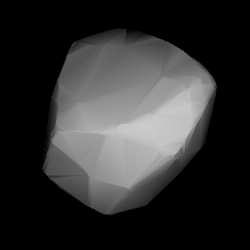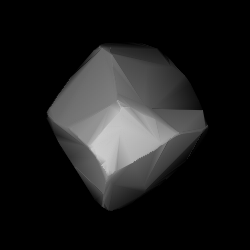Related Research Articles
2009 Voloshina, provisional designation 1968 UL, is a carbonaceous asteroid from the outer regions of the asteroid belt, approximately 27 kilometers in diameter.
2023 Asaph, provisional designation 1952 SA, is a dark asteroid from the outer regions of the asteroid belt, approximately 21 kilometers in diameter. It was discovered on 16 September 1952, by astronomers of the Indiana Asteroid Program at Goethe Link Observatory in Indiana, United States.
1014 Semphyra, provisional designation 1924 PW, is a background asteroid from the central regions of the asteroid belt, approximately 17 kilometers in diameter. It was discovered on 29 January 1924, by German astronomer Karl Reinmuth at the Heidelberg Observatory in southwest Germany. The asteroid was named after the character "Semphyra" in a poem by Aleksandr Pushkin.
1018 Arnolda, provisional designation 1924 QM, is a stony asteroid from the central regions of the asteroid belt, approximately 16 kilometers in diameter. It was discovered on 3 March 1924, by German astronomer Karl Reinmuth at the Heidelberg-Königstuhl State Observatory in southwest Germany. The asteroid was named after physicist Arnold Berliner.
1179 Mally, provisional designation 1931 FD, is an asteroid and long-lost minor planet from the central region of the asteroid belt, approximately 13 kilometers in diameter. Discovered by Max Wolf in 1931, the asteroid was lost until its rediscovery in 1986. The discoverer named it after his daughter-in-law, Mally Wolf.
1049 Gotho, provisional designation 1925 RB, is a carbonaceous asteroid from the outer region of the asteroid belt, approximately 53 kilometers in diameter. It was discovered on 14 September 1925, by German astronomer Karl Reinmuth at Heidelberg Observatory in southwest Germany. Although the name of the asteroid is a masculine German name, it is not known to refer to a particular individual.
1059 Mussorgskia, provisional designation 1925 OA, is a background asteroid from the central regions of the asteroid belt, approximately 25 kilometers in diameter. It was discovered on 19 July 1925, by Soviet astronomer Vladimir Albitsky at the Simeiz Observatory on the Crimean peninsula. The asteroid was named for Russian composer Modest Mussorgsky. The X- or C-type asteroid has a rotation period of 5.636 hours.
1113 Katja, provisional designation 1928 QC, is a background asteroid from the outer regions of the asteroid belt, approximately 39 kilometers in diameter. It was discovered by Pelageya Shajn at the Simeiz Observatory in 1928, and named after Ekaterina Iosko, a staff member at the discovering observatory.
1123 Shapleya, provisional designation 1928 ST, is a stony Florian asteroid from the inner regions of the asteroid belt, approximately 11 kilometers in diameter. It was discovered on 21 September 1928, by Russian astronomer Grigory Neujmin at Simeiz Observatory on the Crimean peninsula. It was named after American astronomer Harlow Shapley.

1457 Ankara, provisional designation 1937 PA, is a stony asteroid from the central region of the asteroid belt, approximately 18 kilometers in diameter. It was discovered on 3 August 1937, by German astronomer Karl Reinmuth at Heidelberg Observatory in southwest Germany, and later named for the Turkish capital city of Ankara.

1635 Bohrmann, provisional designation 1924 QW, is a stony Koronian asteroid from the outer region of the asteroid belt, approximately 17 kilometers in diameter. It was discovered on 7 March 1924, by German astronomer Karl Reinmuth at Heidelberg Observatory in southern Germany, and named for astronomer Alfred Bohrmann.
1215 Boyer, provisional designation 1932 BA, is a stony Eunomian asteroid from the central region of the asteroid belt, approximately 20 kilometers in diameter. It was discovered by astronomer Alfred Schmitt in 1932, who named it after French astronomer and college Louis Boyer.

1555 Dejan, provisional designation 1941 SA, is an asteroid from the background population of the central regions of the asteroid belt, approximately 22 kilometers in diameter. It was discovered on 15 September 1941, by Belgian astronomer Fernand Rigaux at the Royal Observatory of Belgium in Uccle. The asteroid was named after Dejan Đurković, son of Serbian astronomer Petar Đurković.
1271 Isergina, provisional designation 1931 TN, is a carbonaceous background asteroid from the outer regions of the asteroid belt, approximately 45 kilometers in diameter. It was discovered on 10 October 1931, by Soviet astronomer Grigory Neujmin at the Simeiz Observatory on the Crimean peninsula. The asteroid was named after Crimean physician and friend of the discoverer, Pyotr Isergin.
1233 Kobresia, provisional designation 1931 TG2, is a carbonaceous background asteroid from the central regions of the asteroid belt, approximately 33 kilometers in diameter. It was discovered on 10 October 1931, by German astronomer Karl Reinmuth at the Heidelberg Observatory in southwest Germany. The asteroid was named for the grass-like flowering plant Kobresia, a genus in the sedge family.

1283 Komsomolia is a metallic background asteroid and potentially slow rotator from the outer regions of the asteroid belt. Discovered by Vladimir Albitsky in 1925, it was later named after Komsomol, a political youth organization of the former Soviet Union. The M-type asteroid has roughly a rotation period 96 hours of and measures approximately 30 kilometers in diameter.
4944 Kozlovskij, provisional designation 1987 RP3, is a carbonaceous Witt asteroid from the central regions of the asteroid belt, approximately 10 kilometers (6 miles) in diameter. It was discovered on 2 September 1987, by Soviet astronomer Lyudmila Chernykh at the Crimean Astrophysical Observatory in Nauchnij, on the Crimean Peninsula. The asteroid was named for Russian opera singer Ivan Kozlovsky.
2173 Maresjev, provisional designation 1974 QG1, is a dark background asteroid from the outer regions of the asteroid belt, approximately 28 kilometers (17 miles) in diameter. It was discovered on 22 August 1974, by Soviet–Ukrainian astronomer Lyudmila Zhuravleva at the Crimean Astrophysical Observatory in Nauchnij, on the Crimean peninsula. It was named for Soviet war veteran Alexey Maresyev. The assumed C-type asteroid has a tentative rotation period of 11.6 hours.
2022 West, provisional designation 1938 CK, is a stony asteroid from the middle regions of the asteroid belt, approximately 12 kilometers in diameter. It was discovered by German astronomer Karl Reinmuth at Heidelberg Observatory on 7 February 1938. The asteroid was named after Danish astronomer Richard M. West.

1940 Whipple is a carbonaceous background asteroid from the outer region of the asteroid belt, approximately 35 kilometers in diameter. It was discovered on 2 February 1975, by the Harvard College Observatory at its George R. Agassiz Station near Harvard, Massachusetts, in the United States, and named after astronomer Fred Whipple.
References
- 1 2 3 4 5 6 7 "1881 Shao (1940 PC)". Minor Planet Center. Retrieved 9 May 2018.
- 1 2 3 4 "JPL Small-Body Database Browser: 1881 Shao (1940 PC)" (2018-04-21 last obs.). Jet Propulsion Laboratory . Retrieved 9 May 2018.
- 1 2 "Asteroid 1881 Shao". Small Bodies Data Ferret. Retrieved 20 October 2019.
- 1 2 3 Masiero, Joseph R.; Mainzer, A. K.; Grav, T.; Bauer, J. M.; Cutri, R. M.; Dailey, J.; et al. (November 2011). "Main Belt Asteroids with WISE/NEOWISE. I. Preliminary Albedos and Diameters". The Astrophysical Journal. 741 (2): 20. arXiv: 1109.4096 . Bibcode:2011ApJ...741...68M. doi:10.1088/0004-637X/741/2/68. S2CID 118745497.
- 1 2 3 4 Mainzer, A.; Grav, T.; Masiero, J.; Hand, E.; Bauer, J.; Tholen, D.; et al. (November 2011). "NEOWISE Studies of Spectrophotometrically Classified Asteroids: Preliminary Results". The Astrophysical Journal. 741 (2): 25. arXiv: 1109.6407 . Bibcode:2011ApJ...741...90M. doi:10.1088/0004-637X/741/2/90. S2CID 35447010. (catalog)
- 1 2 3 4 Usui, Fumihiko; Kuroda, Daisuke; Müller, Thomas G.; Hasegawa, Sunao; Ishiguro, Masateru; Ootsubo, Takafumi; et al. (October 2011). "Asteroid Catalog Using Akari: AKARI/IRC Mid-Infrared Asteroid Survey". Publications of the Astronomical Society of Japan. 63 (5): 1117–1138. Bibcode:2011PASJ...63.1117U. doi:10.1093/pasj/63.5.1117. (online, AcuA catalog p. 153)
- 1 2 3 4 5 6 7 8 "LCDB Data for (1881) Shao". Asteroid Lightcurve Database (LCDB). Retrieved 9 May 2018.
- 1 2 3 Chang, Chan-Kao; Lin, Hsing-Wen; Ip, Wing-Huen; Prince, Thomas A.; Kulkarni, Shrinivas R.; Levitan, David; et al. (December 2016). "Large Super-fast Rotator Hunting Using the Intermediate Palomar Transient Factory". The Astrophysical Journal Supplement Series. 227 (2): 13. arXiv: 1608.07910 . Bibcode:2016ApJS..227...20C. doi: 10.3847/0067-0049/227/2/20 . S2CID 30387146.
- 1 2 Behrend, Raoul. "Asteroids and comets rotation curves – (1881) Shao". Geneva Observatory. Retrieved 9 May 2018.
- ↑ Veres, Peter; Jedicke, Robert; Fitzsimmons, Alan; Denneau, Larry; Granvik, Mikael; Bolin, Bryce; et al. (November 2015). "Absolute magnitudes and slope parameters for 250,000 asteroids observed by Pan-STARRS PS1 - Preliminary results". Icarus. 261: 34–47. arXiv: 1506.00762 . Bibcode:2015Icar..261...34V. doi:10.1016/j.icarus.2015.08.007. S2CID 53493339.
- ↑ Schmadel, Lutz D. (2009). "Appendix – Publication Dates of the MPCs". Dictionary of Minor Planet Names – Addendum to Fifth Edition (2006–2008). Springer Berlin Heidelberg. p. 221. doi:10.1007/978-3-642-01965-4. ISBN 978-3-642-01964-7.